#chernobyl: zero hour
Explore tagged Tumblr posts
Text
Good: got interviewed by the Wall Street Journal (HELLO) about the artificial turf situation and then spent a few hours hanging out with the angry mothers (+ the single cool nb person) at the park and gave them much of my cool park organizing wisdom (and ended up coming up with the name of their organization 💁🏻♀️). They’re super enthusiastic, they were really receptive to my ideas, and I’m jazzed to see what they come up with. They’re getting their name, website, and social media gang together and I’m going to hook them up with some park resources so they can turn up to the community board with at least one notch under their belt
Not good: They’re so brand new! None of them know anything about plants! They had never considered trying to clean up the park! They have no idea how the process of [checks notes] ANYTHING works and they’re snotty about it because they assume(d) everyone would immediately jump to address their complaints! ‘The park administrator lady was dismissive of us’ yeah because you were telling her how to do her job when you have no idea what the fuck you’re talking about re: the larger issue. What actions are you presenting besides saying ‘we don’t want you to do this’? You say you don’t want turf but you’ve presented zero alternatives, you have no plan on how to move forward given that construction has already started, you have nothing organized, you presented no factual information just a bunch of highly repetitive and emotional anecdotes including comparing synthetic turf and the lack of a report about its composition to the Soviet government’s handling of Chernobyl!!!!
Very not good: the majority of people know each other from a mother’s group so while we were being, you know, interviewed for a front page story in the WSJ, every! single! one! had their child either attached to their faces like a fucking barnacle or running around and pingponging off their bodies. At one point a little boy walked up a random woman, who was not his mother, and started hitting her leg and screaming I want cookies I want cookies like hello???? Whose fucking kid is this! And she just acted like it wasn’t incredibly annoying and he kept doing it until I said ‘other people are talking you need to wait your turn’ and then he was completely silent until a full five minutes later when his actual mother showed up. She then gave him a) a cookie b) an iPhone to play a video game (full volume) while seated directly next to the WSJ reporter until I suggested they move down the bench. Are you fucking kidding me. This is the metro New York reporter for a newspaper of record interviewing us about a major environmental cause. All of these kids are under THREE YEARS OLD WHY ARE THEY HERE when I’m trying to tell this journalist about the lack of a Parks capital budget!!!!!
Bonus: the park moms were joking that I don’t like kids because I was the only person childless who told a kid to stop behaving badly (insane and authoritarian behaviour To Them) but then they left and a tiny 5 year old girl named Esmé on a scooter zoomed over to me and asked if I would race her because she didn’t have any friends and we chased each other around for a bit while her parents smoked on a bench and she ran over my foot but apologized. When they left, she gave me a single piece of popcorn and two huge hugs and said that we were best buddies 🥺🥺🥺
#not even playing favourites but the nb person had the cutest and best behaved kid#but then their partner showed up and was the cishettest white man to ever cishet and I was just like aren’t you tired of this#dispatches from the park
10 notes
·
View notes
Note
do you mind sharing why that showrunner rubbed you the wrong way? totally get it if not, just curious as to what kind of dynamics can form in zoom workshops like that
Sure, anon, I don't mind at all!
Basically I'm in a database of emerging and developing writers that my state film body maintains, and as a part of that I sometimes get invited to apply to participate in creative and professional development opportunities. I've gotten into a few actually, which is always exciting (especially since the state film body pays for it, haha, so it's free for me if I'm accepted in) - my favourite one I ever did was with Meg LeFauve who wrote Inside Out and Captain Marvel, among many other things, and was just genuinely so wonderful and generous with her knowledge and encouragement.
This particular one though was basically a full day of back-to-back one hour sessions over Zoom, and the whole day was pretty great and stacked with Australian and overseas talent. I did (among others - these are just the ones I remember off the top of my head) a session with Prentice Penny (Insecure), Sierra Teller Ornelas (Rutherford Falls), Lucy Prebble (Succession and Secret Diary of a Call Girl), Jo Werner (Dance Academy and Surviving Summer), and Craig Mazin (Chernobyl, The Last of Us).
I'm kinda saying this to give context to the fact that the day itself was A Lot, and was really about giving a lot of different insights to a lot of different creative processes and professional writing environments, and I think one of the reasons Craig rubbed me the wrong way so much was that his approach really jarred with the other writers. In all the other workshops, the writers had emphasised the value of collaboration, supporting other writers, and expressed a really deep love of film and TV not just as an industry, but as an artform.
Craig writes alone - he wrote every episode of Chernobyl and has written every episode of The Last of Us except for two episodes he co-wrote with the creator of the game - which was a fact he emphasised a few times, and he felt really dismissive overall of any voice that wasn't his own. He hosts an entire podcast on screenwriting, which he talked about a lot, and talked about how he enjoys talking to other writers, but won't watch their work because he doesn't like watching movies and TV shows, and he basically bagged out TV as a medium outside of the work he himself was creating. He just came across as intensely arrogant to me, and while everyone else was offering advice and guidance in their sessions, Craig really just... talked about himself.
I don't know, maybe my thoughts would've been different if I'd seen his session in isolation of the others, but I've referred to my notebook from that day plenty of times since, and his is the only workshop that I took literally zero notes in. It's also - - mmm - - maybe telling of other things too? Given every other writer throughout the day was either BIPOC or a woman, I have in hindsight thought that the importance of seeing and supporting stories by diverse voices and building up your industry has very different meaning for writers that aren't straight white men like Craig, but I don't know. All I know is that I left his session with a bit of a bad taste in my mouth.
7 notes
·
View notes
Text
Atomic Heart
Developed by Mundfish
Published by Focus Entertainment
Release Date 2023
Tested on Xbox Series X
MSRP 59,99 USD
youtube
(Please note that this is review-in-progress and only contains first impressions.)
“I don’t care if we are burned at the stake, we won’t reject our convictions.” reads a billboard in Atomic Heart, in Russian. I may be fallen victim to yet another great promises of a game, once again. Atomic Heart is dazzling in trailers and showcases, what about the ACTUAL game? That is a tough pill to swallow, I’ll walk you step by step my hands-on experience.

Atomic Heart is a futuristic game, set in an alternate universe in this highly-technological version of the Soviet Union. The official description portrays the game as “utopian”, well that’s open to interpretation, still my judgment favours more of “dystopic” world, backed up by the literary work I’ve consumed over the years. The reason is that, there’s always something going on in the background if all the characters you meet are all-smiley and looking jolly (and pretending to be happy), and that ‘something’ slips and changes everything for good. As the protagonist, we get to know what goes wrong right after the beginning, I’ll talk about it later.
First thing you’ll realize is that the game was developed with English voice-over in mind whereas text on billboards, posters etc. is in Russian. When the cursor is on the Russian text, English translation is displayed automatically on the screen. This hybrid approach works better than I expect, yet I have this gut feeling that the atmosphere and density of the game would have worked much better if the voice-over was in Russian, after all we’re in this alternate Soviet Union with cold war aura. Why not go all the way Russian? I had the same complaint when I was watching HBO show, Chernobyl. Obviously, it was a creative choice to produced the show in English and not in local language. You’re losing that touch because you’re two times-removed from the original language, environment, characters, feelings, dialogues etc.
Below, you can find some examples of English translation over Russian posters and billboards.




Below, you can find a clip from the opening sequence, look at this amazingly-designed colourful world, because this is your glimpse at it, ouch.
youtube
Enough for digression, let’s kick off with the opening sequence. It is phenomenal and exceptional with its top-notch soundtrack (I have the main theme on repeat while writing this piece), a gigantic and glorious world with cold war era inspired Soviet aesthetics welcome us, then we’re left in more confined and enclosed spaces, to put it honestly. When you compare the actual game to the opening, it would be surprising not to be disappointed because in the next two hours you’ll be crawling in unremarkable locations, basements, buildings, places resembling to sewer systems. When you’re doing that, you’ll be randomly collection material to create, upgrade your gear and improve Charles (your glove companion). The only way throughout this exhaustive and non-entertaining journey to learn about what’s happening, background story and lore is rarely-found recordings. I hoped and thought that as our companion Charles would be introducing us, the player, to this world and establish some ground for lore, considering well-crafted opening intro. Yet I was let down, the game fails at engaging with the player, this is a weird situation because often games do try to bond with the player and fail. In Atomic Heart’s case, there is zero attempt from the game, let it be narration, environments, enemies, Charles, collectibles. As the player, I know this isn’t a good sign when I wish the game will start rolling after a tipping point. Spending (and even wasting) time in un-interesting underlit generic-type locations is such a bore and the game loses momentum and attraction rapidly. I couldn’t help myself asking “why are we going through these places one after the other and not feeling any progression?” The thing is that, you collect numerous currencies for upgrades in these early locations, and what you get in return is almost missable improvements for Charles. I mean, during the first two hours you are not even unlocking a new gun, guns are unlocked with “recipes” (that I did not encounter in the first two hours). There’s a clear pace problem, a player shouldn’t be expected to play a game for hours and not achieve anything.

When it comes to technical side, oftentimes you’ll find either your cursor does not register or the character will be unable to vault shortly after jumping. The game has received multiple patches upon release, still it is cumbersome to control the game, and I had to re-launch the game a couple of times because the cursor was not moving on the upgrade menu.
The promise of the story is going ups and downs as well: in this alternate reality Soviet Union is so advanced in robotic technology with the mysterious element called Polymer that the state holds an event, then it turns out robots are out of control due to a critical error. As the protagonist, named P-3, we take the role of solving what’s gone south.
All in all, Atomic Heart had been a game I wanted to like and enjoy myself playing. Not many studios develop a game in an alternate world set in Soviet period, I was hyped for this fresh take on futuristic setting but this is not enough, falls short on expectations.
2 notes
·
View notes
Video
youtube
Chernobyl - Evacuation of Pripyat
Attention, Dear comrades! The City Council of People’s Deputies reports that in connection with accident at Chernobyl nuclear power plant in the city of Pripyat, an unfavorable radiation situation develops.
Party and Soviet bodies and military units take necessary measures. However, in order to ensure the complete safety of people, and, in first place, children, it becomes necessary to temporarily evacuate the residents of city to nearby settlements in Kyiv region.
To this end, to each apartment building today, on April 27, starting from fourteen hours after zero, a bus will be served accompanied by police officers and representatives of the city executive committee.
It is recommended to take documents with you, extremely necessary things, as well as, for the first time, food. Heads of enterprises and institutions defined the circle of employees who remain in place to ensure the normal functioning of the city’s enterprises.
All houses for the period of evacuation will be guarded by police.
Comrades, temporarily leaving your home, do not forget, please, close the windows, turn off the electrical and gas appliances, turn off the water taps.
Please observe peace, orderliness and order during temporary evacuation.
6 notes
·
View notes
Text
Hasidic Judaism
Currently listening to: Bring it On Home to Me by Sam Cooke

The Hasidic movement began in the 18th century and was founded by Rabbi Yisroel Baal Shem Tov. The movement began during a time of religious persecution and spiritual decline, and it sparked a religious renaissance due to its teachings that valued love, joy, and humility. The movement essentially supplemented religious study with a joyful experience of prayer, D'vekut. While I watched the documentary, D'vekut: Hasidism & Jewish Mysticism, I learned a few other things about Hasidism.
Hasidic values follow four basic ideas:
The all-inclusive and unconditional love for every Jewish soul and every part of creation.
The spiritual importance of always retaining a psychological state of joy as a way to serve G-d.
All of the Mitzvot (this word refers to the 613 commandments) given to Jews are there in order for them to experience and understand the state of clinging to the G-d that gave them those commandments.
I honestly for the life of me cannot remember or find in the transcript what the last one was.
I also learned about two important religious figures to the Hasidic movement aside from the founder:
Rabbi Shimon Ben Yochai established a school of mysticism and wrote the Zohar, or the book of splendor. This is the essential book of Kabbalah, or Jewish mysticism.
Rabbi Isaac Luria, or the Ari, was a renowned scholar of Kabbalah. In the 16th century, he made the Kabbalah practice and accessible.
The documentary talks a lot about what is considered "Hasid" and what is not. One of the main points of it is seeing the good part of everything that happens, including suffering, and being able to thank G-d for what one learns from those things. Another is to rebuild the Jewish nation up again, like when Rabbi Yechezkel Boruch Halberstam built a hospital in a less religious area of Israel, where anyone seeking treatment could find it. The documentary talked about how at the time of its filming (it came out in 2000, so probably around like 1998-1999 because it took two years to film), 50,000 babies had already been born in the hospital and how this was helping rebuild the Jewish nation after the Holocaust.
Hasidic Jews are not just one block of people, but a community with different groups. Here are the most popular:
Gur (Poland, today, mostly in Israel).
Chabad Lubavitch (Lithuania and Belarus, today concentrated in Crown Heights, Brooklyn; and Kfar Chabad, Israel, but spread throughout the world).
Satmar (originating in Satu Mara, Romania, today concentrated in Williamsburg, Brooklyn, as well as Kiryas Yoel, Monsey and elsewhere).
Bobov (Galicia, today very prominent in Borough Park, Brooklyn).
Belz (Galicia, today mostly in Israel with significant communities in New York and Montreal).
Vishnitz (Ukraine, today, mostly in Israel and Monsey, N.Y.).
Breslov (Ukraine, today spread throughout the world).
Chernobyl (Ukraine, today in New Square, N.Y., and around the world).
Sanz-Klausenburg (Galicia, today concentrated in Netanya, Israel).
I decided to read a bit more after I finished the documentary, which was about an hour long. Chabad.org has a really interesting page on things about Hasidic Judaism that I really liked reading.
One thing I learned was that Hasidic Jews receive guidance from a Rebbe, which is the Yiddish pronunciation of Rabbi. There is no formal application process required to become a Rebbe, they are simply people who have devoted their lives and put a lot of energy into cultivating a relationship with G-d and who immerse themselves in study, contemplation and prayer. They are meant to help guide and inspire their community.
I also learned a few things that I saw in the documentary: They value songs and stories. Though they use technology, some use it with limits to how much and which ones they use. Television is considered off-limits, and in virtually every Hasidic community, internet usage for minors is limited to very little or zero usage. This definitely surprised me a little, but as someone who had way too much access to the internet as a child and...saw some things...I'd say that's a pretty solid rule.
Another thing I learned was that some people call these communities "ultra-orthodox." I noticed there were a few documentaries that had this title, and I thought it seemed a bit sensational (especially since most documentaries that Vice produces are a bit sensational in nature and tend to document different groups a tiny bit like zoo animals? They just always have a weird tone, even if it is pretty informative) so I'm glad I scrolled past them because I was right. Apparently, many view this term to be pejorative. It's better to just call them Hasidic (Chasidic) Jews. Or just Jews.
Notes:
Even though this is a bit off topic, I'll never get over being named Brooklyn and never having even seen the Brooklyn bridge or set foot within the borough. I wish I had though, because then I think I would have had a chance to be exposed to a different style of religious dress than I had been. Now that I know more about how some Hasidic Jews look and dress, I realize that I do have extremely vague memories from when I was a child of seeing very tall men (or maybe I was just very tiny) in black hats with the Pe'ot and staring extremely hard at them by trying (and most likely failing) not to.
I remember doing the same thing the first time I saw Mennonites in Missouri when I was younger. I was just so intrigued but shy as hell. Sorry to the people I might have made uncomfy with that. Also notable is the fact that I do feel like I have vague memories of my dad saying Jews made the best bagels or something like that, and yes, he said it exactly the way you'd expect someone rude to say it. I don't know if anyone has caught on yet, but my family had a very strange mindset where they thought if they basically were hateful to everyone it cancelled out the bigotry because they were equally bigoted toward everyone and not just one group?
Y'all see why I work so hard to educate myself? Good lord. I actually think my first introduction to most minority groups was through some form of racism or something. I also wanted to add that I chose to do the G-d spelling because that's what I kept seeing in my research, and I wanted to be respectful of the topic. Typically, I would just use the O, but I am a big fan of trying my best to be respectful. Anyway, I really enjoyed learning about this topic and will definitely continue to learn more about the different rules that they live by.
0 notes
Text
Field Effect: Time Warp
“Let’s do the Time Warp Again!”
Signature Field Effect for the Timekeeper.
General effects:
All Pokemon coming into battle are subjugated to the Time Warp. If your Pokemon faints, instead of fainting immediately, it devolves into its prior stage, if possible. All status conditions (Burn, Poison, ETC.) and existing volatile conditions, not including raised or lowered stats, are removed. Mega Evolution is included. If your Pokemon is a Basic Pokemon, it will faint if the usual conditions apply. This effect is not permanent.
If your Pokemon is revived, it will be revived at its default evolutionary stage. (ie if your Swampert is knocked out as a Mudkip, and you use Revive on it, it will be revived as a Swampert.)
Pokemon that have evolved and can still evolve again (Machoke, Porygon2, etc.) gain an Eviolite Boost. Stacks with Eviolite. Pokemon that have 2 evolutions gain 2 stacks of Eviolite Boost, which additionally stacks with Eviolite.
Paradox Pokemon are changed into their normal forms upon defeat. For example, Iron Treads and Great Tusk will change into Donphan, and such forth. Koraidon and Miraidon are exempt from this rule. (Iron Valiant will transform into either Gallade or Gardevoir, depending on the higher attacking stat, or random if tied.)
Terastalizing your Pokemon gives them +1 in their main attacking stat.
This field cannot be neutralized or changed in any way.
Weather cannot be generated on this terrain, except Nuclear Fallout.
Abilities Affected:
Galvanize now adds Steel-Type to Normal-Type moves in addition to changing to Electric-Type
Contrary now only affects negative stat changes
Magnet Pull increases DEF and SP.DEF by 1 stage.
Wonder Guard additionally acts as Magic Guard.
Triggers Electromorphosis at the end of each round.
Triggers Protosynthesis and Quark Drive. Pokemon with Protosynthesis and Quark Drive are immune to Nuclear Fallout.
Pokemon with Orichalcum Pulse and Hadron Engine, instead of generating weather/terrain, gain +1 in all stats, except accuracy and evasion. Pokemon with Orichalcum Pulse and Hadron Engine are immune to Nuclear Fallout.
Pokemon with Primordial Sea, Desolate Land, or Delta Stream, instead of making weather conditions, gain immunity to Fire and Water moves respectively, and gain +1 in all stats, except accuracy and evasion.
Pokemon with Embody Aspect gain +1 in all stats.
Tera Shift will gain +1 in all stats, except accuracy and evasion. Teraform Zero will further boost these stats by an additional +1, but not neutralize the field effect.
Tera Shell reduces all incoming damage to .75x and prevents stat loss.
Pokemon with Atomizate gain 1.1x power with all their moves.
Pokemon with Lead Skin now take .75x damage from any source, except Nuclear-Type, which still has immunity.
Pokemon with Geiger Sense have their ATK and SP.A increased by +1.
Pokemon with Chernobyl increase all stats by +1, and the generated Nuclear Fallout lasts the entire battle.
Moves that gain 1.5x Power:
“Time is Bending!”
Roar of Time
Spacial Rend
Hyperspace Hole
Hyperspace Fury
Tera Starstorm
“The Future is Now!”
Gear Grind
Techno Blast
Electro Drift
Future Power (In addition, triggers one turn sooner and can be affected by Power Herb)
Doom Desire (In addition, triggers one turn sooner and can be affected by Power Herb)
Electro Shot
Psyblade
Mighty Cleave
Tachyon Cutter
All Nuclear-Type Moves.
“Prehistoric Power!”
Ancient Power
Wood Hammer
Bone Club
Bonemerang
Bone Rush
Shadow Bone
Collision Course
Origin Pulse
Precipice Blades
Dragon Ascent
Hydro Steam
Ivy Cudgel
Thunderclap
Other Moves affected:
Shift Gear now additionally gives one stat of Evasion.
Crafty Shield now protects against damaging moves.
Gear Up works no matter your ability
Happy Hour additionally adds Life Dew’s healing for all allies
Heal Bell works like Jungle Healing
Ion Deluge additionally gives the next Steel-Type attack an Electric sub-type.
Perish Song now randomly either has one additional tick or removes one tick when applied to each Pokemon. (Either a 4 turn countdown or 2 turn)
Bad Poison as a result of Toxic, Poison Fang, or Toxic Chain gains one additional tick at the start of application. (Begin at 12% damage and works up from there)
Nature Power becomes Roar of Time.
Camouflage makes the user the Steel-Type.
All Steel, Psychic, and Electric moves gain 1.1x power
Steel Roller, even though there is a Terrain present, will always fail. Certain Max Moves, Defog, Ice Spinner, and Splintering Stormshards, will all still work on the opponent, yet not be able to change or remove this field effect or the weather.
Burning Bulwark now deals additional reflected damage like Spiky Shield.
Items affected:
Eviolite now boosts the ATK and SP.A of the holder by 1 stage. This also applies in the Eviolite Boost this field provides. Still only applies to Pokemon that can evolve. (Mega Evolution doesn’t count)
Metronome, Thick Club, Twisted Spoon, and Magnet increases the main attacking stat of the user upon entering battle. All Reborn Field effect seeds have an effect on this Field;
Synthetic Seed: Boosts SP.A and applies Magnet Rise to user.
Elemental Seed: Boosts ATK and SP.A by one stage.
Telluric Seed: Boosts ATK and gives Priority to next move.
Magical Seed: Boosts SP.ATK and gives Priority to next move.
Adamant Orb and Lustrous Orb now Primally Reverts Dialga and Palkia to Origin Form, and gives +1 to all stats of the holder, except Accuracy and Evasion upon switch-in if they are Dialga and Palkia, respectively.
Griseous Orb, Blue Orb, and Red Orb gives +1 to all stats of the holder upon switch-in if they are Giratina, Kyogre, and Groudon, respectively.
1 note
·
View note
Text
MAKING A NICKNAME POKEDEX FOR SCARLET AND VIOLET SO HONEST TRAILERS DOESN'T HAVE TO
without the pictures but like here's a link to the full dex https://www.serebii.net/scarletviolet/pokemon.shtml
S T A R R I N G
litten's lolitacore sister
become bipedal
mewdini
applegator
flower crown clown
unrelated to skeleramjet and skelethrust
donald duck
donald duck with a mullet
donald duck: pride parade edition
peppa pig: depression form
karen hog
seriously? a dunsparce evolution?
charlotte's epic yarn
become quadrapedal
jiminy cricket
criminy jicket
great balls of shit
spirit bomb
the ottoman from beauty and the beast
the imprisoned
baby hat
low-hanging fruit
hoodie
long dennis
long dennis's extended family
the whiscash she tells you not to worry about
i don't know what a hake fish is
ecco
tighten from megamind
sadboy hours
femboy hours
christmas tree
a chicken
big manhandla
fish egg with a face
4 eyes
down the gasoline trail
the bird car from power rangers RPM
succumb to the worm
the shining twins
rat movie
a literal toddler
spike ball head
another literal toddler
backpackhacksaw
totally not haxorus
sushido
they see me rollin'
plushiebait
plushiebait that could kill you
plushiebait that WILL kill you
deer in headlights
thunderbird
the stork that brought me into the world
mondo
night of the living lawn flamingo
kingler's dad
a snail
minecraft sheep
low tier god
parasite connected to an onion
I have no fucking clue
how does this evolve into a monkey
smell my finger
world's best dog
this thing is edible right?
a dog that is in pain
puppy dog eyes
the burning bush post-rehab
keanu reeves
mimic
wacky waving inflatable C3PO
the ice age mammoth pre-rehab
among us: zero dawn
become pedal
starvingbox
hair arms
walking flower
librarian hair
droideka
mechamothra
weak spot hands
ghetsis's revenge
literal mechagodzilla
amazon wish list
galladevoir
stu
the jaguar from ice age
the chernobyl moss
the final boss of okami
tire boob
the bike from akira
literal toddler 3
goo goo from clayfighter 2
king dedede's daughter
literal toddler 4
a probably more fitting evolution than ceruledge
pokemon: battle network
the zombies from the last of us
gas mask
sword mohawk
fecalsire
AND
oni from street fighter
Performance issues
1 note
·
View note
Text
There were a couple of them involving the discrimination Black soldiers underwent during WWII called Honor Deferred on the History Channel. There was one called Zero Hour, I think, which did a countdown to several historical catastrophes (Chernobyl, the subway gas attacks in japan, etc.) by reenacting them.
There was one that was, again I don't remember the title, but it was about what happened after Jackie Robinson blew open MLB for Black people and the struggles that others had to join in the sport. If any others stuck out, I'll add them!
what are ur favorite science and/or history documentaries
141 notes
·
View notes
Text
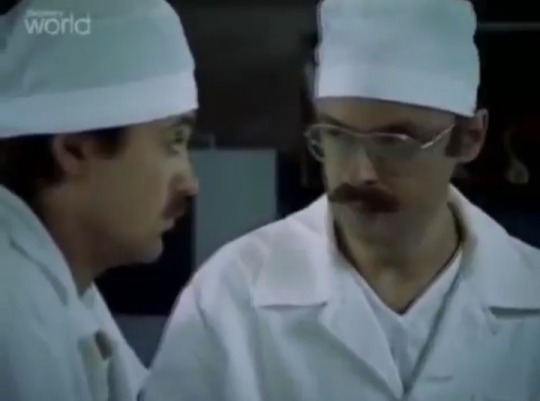
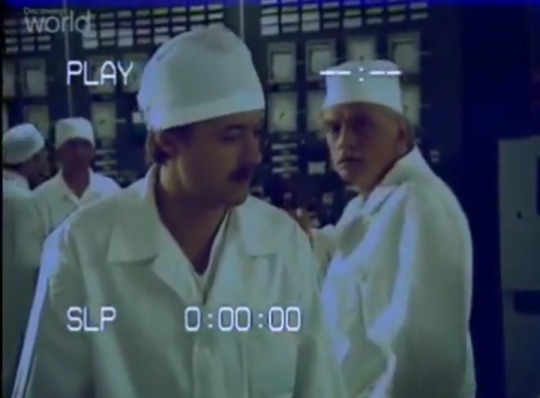
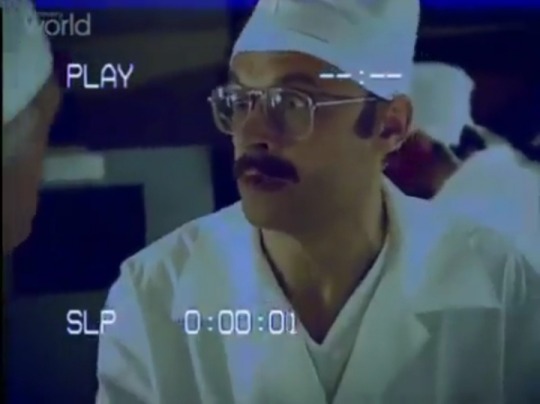
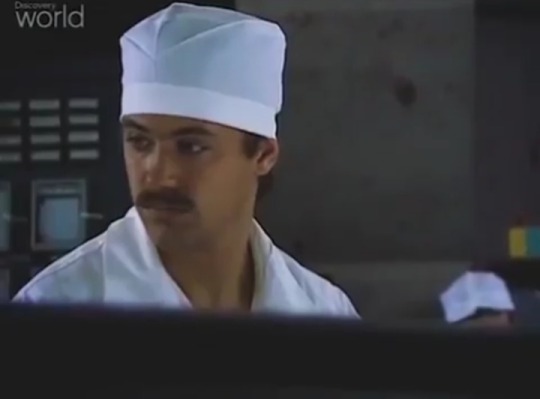
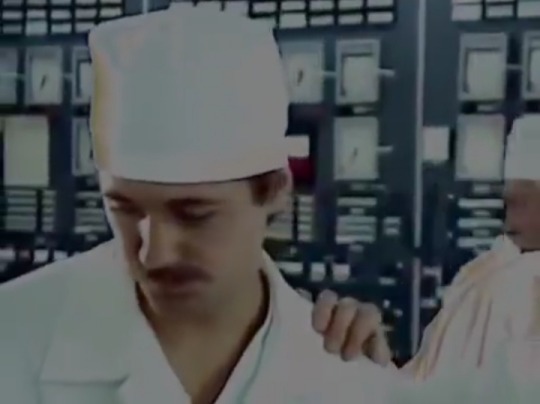
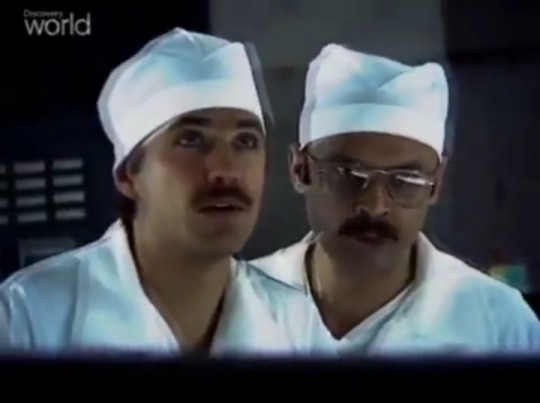
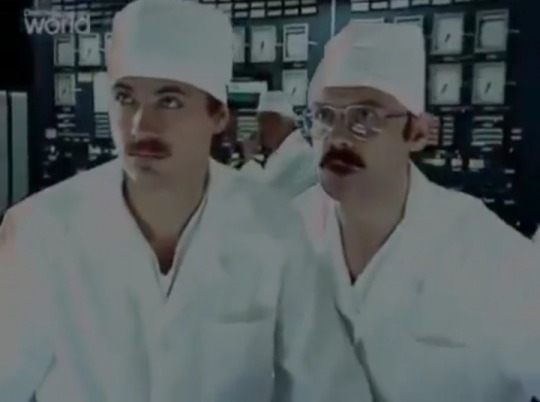
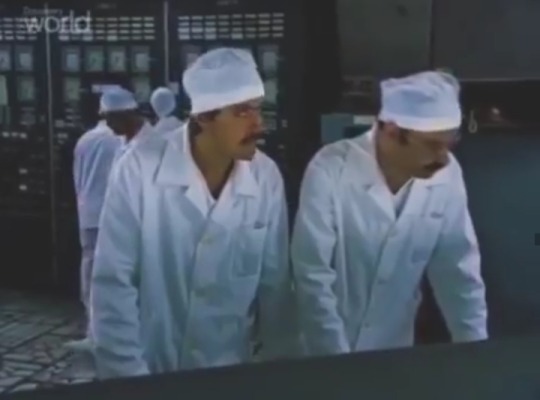
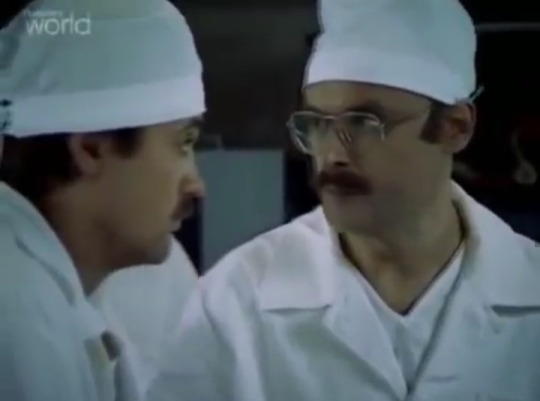

Lenoid Toptunov and Aleksander Akimov in the documentry Chernobyl: Zero Hour ❤
@tryingtobealwaystrying, @@elenatria, @valerafan2, @fmasha-l, @kriegskrieg, @kriegsverlobte, @toptunovs, @russian-senpai, @alyeen1, @drunkardonjunkyard, @siriuslymeg, @johnlockismyreligion, @legasovswaifu, @litttlesilkworm, @dank-hp--memes, @shit-in-silk-stocking, @borisboyfriend, @attachedtofictionalpeople, @thegreenmeridian, @shark-from-the-park, @az-5-elimgarak, @cocomoraine, @pottedmusic, @jedikatalina, @potter012, @gwinny3k, @gwaciechang, @liza801, @comrade-dyatlove, @live-long-and-time-warp, @itisa-profoundbond-sarandom, @green-ann
#chernobyl#chernobyl: zero hour#aleksander akimov#alexander akimov#leonid toptunov#toptumov#history#soviet union#ukraine#pripyat#1980s
45 notes
·
View notes
Photo

Disaster at Chernobyl Renny Bartlett UK/Canada, 2004
#Disaster at Chernobyl#Renny Bartlett#2004#2000s#documentary#title card#Zero Hour: Disaster at Chernobyl#Zero Hour
0 notes
Text
No one asked, but my grade of the new HBO documentary “Chernobyl: The Lost Tapes” is a B-.
I would recommend it specifically for people who already have some background in Chernobyl. In fact, I would recommend the drama series “Chernobyl” from HBO for beginners first.
It is very well put-together and the tapes were incredible. They had several actual impacted people and liquidators and they emphasized how the Soviet state made their work infinitely harder, if not impossible. If I didn’t know anything about Chernobyl before I watched it, I’d give it an A.
However… there is zero mention of Valery Legasov, Boris Shcherbina, Nikolai Ryzhkov, or many other of the the key figures who made the liquidation possible. They also don’t really go into detail about the plant staff that acted heroically in the hours after the accident, it’s very superficial.
They mention things like the report presented at the IAEA conference in Vienna in 1986 and how they made everyone sign non-disclosure agreements, but failed to mention that when Legasov and his colleagues wrote that report, they did it with the utmost honesty and were very nearly imprisoned or worse for it. The Soviet government overhauled that report to make it less truthful after that. They also fail to mention that Legasov was sent to Vienna when Gorbachev should have gone, and spoke with foreign journalist as truthfully as he could without getting shot while he was there.
They show Gorbachev visiting Chernobyl for the first time in 1989, without acknowledging that Shcherbina is in the background of the same tape because he insisted on going to Chernobyl when he heard Gorbachev was going. He was very sick at the time (very likely because of all the time he spent at Chernobyl, literally more than anyone else) and went there against doctor’s orders. They also don’t mention how on the flight back, he had a heart attack and was only saved because there was a medical professional on board.
To me, this fundamentally misses many key facts of the Chernobyl story, and that makes it inherently incomplete.
It is also sometimes hard to follow who’s speaking, as you only hear audio, you don’t see the actual interviewees.
Lastly, it borrows a lot of thematic elements from the HBO drama, which isn’t necessarily a bad thing but to me it was a little distracting.
Overall, not a bad piece at all and certainly worth watching, but it’s definitely not a comprehensive resource on the Chernobyl accident.
#chernobyl#valery legasov#boris shcherbina#chornobyl#chernobylhbo#ukraine#soviet union#Ukraine#russia#jared harris#belarus#europe#stellanskarsgård#emily watson#chernobyl: the lost tapes
36 notes
·
View notes
Text
Then buckle up and get ready for my ramble on a subject I hyperfixated on for a solid 24 hours. (Also tw for body horror because I get into explicit detail here)
Let’s start with what radiation is. To put it as simply as I can, atoms move a lot. The movement of the atom itself is energy. The faster the speed, the more energy. This is also known as heat. The spaces between the moving atoms, however, are what we call waves. Radiation is basically that movement between the atoms. We mostly know these particular waves as light and sound.
There are multiple types of radiation from Microwave to Gamma radiation, in order from longest to shortest wavelength and lowest to highest energy respectively. Microwaves, due to being low energy, are the least dangerous, and due to their long wavelength, struggle to go through objects. (And by that I mean the wave’s ability to pass through atoms. This ability changes with what it’s passing through).
Fun fact: Our skin actually blocks most forms of radiation, however the higher the energy of the radiation, the more it can damage the skin cells. This is why it’s important to always wear sunscreen outside even if you have dark skin.
The reason I bring this up is because Gamma radiation, along with X-Rays, can go through our skin very easily.
Gamma radiation is what we primarily find in nuclear reactors, nuclear weapons, and our own Sun. This kind of radiation is caused by atoms with very unstable nuclei that are rapidly moving and creating very fast, very short waves.
So how does this affect a human body?
If a person is exposed to over 100 rads of Gamma radiation, they can get what is called Acute Radiation Sickness. If you’ve seen HBO’s Chernobyl you probably know exactly what I’m talking about.
At a molecular level, radiation actually begins binding to your cells very rapidly, and the first thing it does is vibrate so hard that it breaks apart your DNA, or more specifically, the chromosome that controls cell division and cell repair. This essentially destroys your bodies ability to replace new cells.
The first stage is burnt skin and vomiting, as your body tries to dispel everything, including the infected skin cells.
The next stage is called the Walking Ghost Phase. This is because the irradiated person seems perfectly fine and healthy all of a sudden. However, this is only because their healthy cells haven’t died yet, as skin cells take 7 days (give or take) to replace themselves.
After this stage, the cells that divide the most rapidly begin to die out. This includes hair and nails, and shortly after, the skin. With no ability to split, your body can’t replace the cells, and your body begins to decay.
The next to go is your immune system. The marrow in your bones has decayed and can no longer create blood cells. Your white blood cell count drops to zero and other diseases begin to attack.
Because you can also no longer create red blood cells, you no longer have oxygen flowing to your extremities, and since the skin and muscle cells are already dying or dead, your limbs begin to rot away.
Finally, your organs. With all of this, your organs are working overtime and dividing quicker than normal. The inner lining of your stomach and intestines sloughs off, causing rapid diarrhea which has the side effect of dispelling most of the liquid in your body. Your lungs, and other organs start falling apart, and finally your heart gives out.
It doesn’t stop there either.
Because radiation binds to your bones and can’t be removed, your body is a hazard to others and can actually irradiate other people. Everyone who died of ARS after Chernobyl melted down was sealed in a lead casket and encased in concrete to prevent the radiation from spreading.
Nuclear energy, while very powerful and certainly much more efficient than oil, is really fucking dangerous. There are certain forces in our world that you cannot rush or skip steps with, at the risk of harming the entire world and everything living on it.
Chernobyl melted down due to those in command of the USSR not only skipping steps in safety, but also being so fucking cheap as to make the tips of the reactor cooling rods out of fucking graphite which is extremely reactive with the elements in the core. The radiation coming off this reactor was so fucking dangerous that three men known as the Chernobyl Liquidators had to essentially perform a suicide run to turn the water release valves in reactor 4 before it could melt down. Had reactor 4 also melted down, the radiation it would’ve given off would have covered most of Europe and possibly even carried over to other continents, and poisoned everyone living there. (Those three men survived btw, and two are still alive today.)
TL;DR: Gamma radiation vibrates cells so hard it breaks the part of your DNA responsible for cell division and your body rots/melts from the inside out.
(Note: I am not an expert in radiation or in Chernobyl; I’m just basing this based on what I’ve learned doing aerospace and what I learned the other day. If I got something wrong, please feel free to add on.)
Do you ever just randomly pick up a subject and hyperfixate on it for an entire day and then literally never think about again?
On an unrelated note, does anyone want to know about how radiation unravels DNA?
#random#that was a whole tangent and I apologize for the length#radiation#tw body horror#science#nuclear science#tw radiation sickness#chernobyl
86 notes
·
View notes
Text
TAGGEDD BY @oliverbanks TO SAY 6(i think. Memory is ass) SONGS.IVE HAD ON REPEAT
Vienna - Billy Joel (i listen to that song every single night so its always on repeat..)
Heart of the Android - Orden Ogan
The Other Side - Black Star Zero
Sons of Fate - The Protomen
Dogs of Chernobyl - Megadeth
The Waking Nightmare - Frankenstein Musical
ACTUALLY I JUSZ REMEBERED ALSO ITS STILL ROCK AND ROLL TO ME & ONLY THE GOOD DIE YOUNG BY BILLY JOEL . THAT MAKES IT.MORE THAN SIX BUT THOSE SLAP AND I HAD THEMM ON PROPER REPEAT FOR LIKE 3 HOURS THE OTHER DAY
And HMM thats it i think. Tagging adam @freakspacecadet BUT ofc only if you want. IDK WHO ELSE TO TAG I APOLOGIZE
#well to be fair ive mostly been listenjng to my fave 3 albums by my fave band lately. b ut if anyone i know listened to some of those songs#i would die of autism identification possessiveness so im not telling those. so these are the other ones ive been listening to a lot
4 notes
·
View notes
Video
dailymotion
In case you’re interested of what happened in Chernobyl in 1986, Zero Hour’s documentary Disaster at Chernobyl is a must to watch
#documentary#chernobyl#chernobyl nuclear power plant#chernobyl nuclear disaster#nuclear disaster#history#recent history#1980s#80s#1986
2 notes
·
View notes
Text
Clear evidence of Russian troops rounding up Ukrainian civilians and using them as human shields has been found by the BBC. In multiple interviews in Obukhovychi, villagers say they were taken from their homes at gunpoint and held in a school by Russians trying to stop advancing Ukrainian forces. Local people also gave accounts of Russian troops shooting civilians and holding others captive in and around Ivankiv, the neighbouring town.
On the night of 14 March, Russian soldiers in Obukhovychi were under attack and losing men and armoured vehicles. The Ukrainians were regaining territory.
As darkness fell, local people, sheltering in their cellars, heard explosions and the grinding sound of armoured vehicles manoeuvring.
They had been under Russian occupation since the start of the invasion - the area was on the main axis of Russian advance. Obukhovychi is 100km (60 miles) from Kyiv, close to Belarus and just south of the exclusion zone around the site of the Chernobyl nuclear disaster.
We have now managed to speak to many people about what happened that night. They all told us the same stories about 24 hours that traumatised the village.
Families described how the Russians went door-to-door, rounded them up at gunpoint, and marched them to the local school - where the Russian forces used them as protection.
Many of the houses in the village had the Ukrainian word for "people" painted on their gates - a way of warning soldiers to be careful and not hurt them. But, in the end, the signs were a magnet to Russian troops.
We were told that if people didn't open their doors, the Russians broke them down. About 150 civilians, including the elderly and small children, were taken from their cellars to the school.
"The [Russians] are fascists, vandals. It was chaos, children and people crying… I don't want to talk about the Russians. They're not human beings," 60-year-old Ivan told us.
Lydmila Sutkova described the terror of being rounded up at the school. "When explosions came, we thought if the ceiling falls this will become a mass grave."
Others told us that some of the Russian soldiers were drunk, and threatened to take them to Belarus.
Maria Bilohovost, an 89-year-old great grandmother, told us she had survived World War Two and that the Russian invaders were like the Germans. "Except they spoke Russian, so I knew what they were saying."
She said the Russians left her in the house but took the rest of her family - including her granddaughter Maryana and great-granddaughter Marharyta. Maryana says two-year-old Marharyta still shows signs of anxiety.
Maryana's mother Olena tells us that she was afraid they would all be shot in the gym. "I was scared for my daughter. I don't have the words. I'm still frightened. Machine guns - a two-year-old girl should not see this."
Olena says that while the Russians were occupying the village, young women and girls hid inside their homes. "We were really terrified. One lady went to collect wood for the fire in her house - she was shot in the leg. They just did it for fun."
In Obukhovychi, there was no mass slaughter of civilians - but we were told stories of individuals, including a local priest, being killed.
Up the road, the nearby village of Termakhivka is built around a desolate crossroads, where routes lead to Belarus, Chernobyl, Warsaw and Kyiv. There were burnt out military vehicles and military emplacements - once held by the Russians, we were told, but now manned by Ukrainians.
One local man, 25-year-old Bogdan, says he was held captive for 15 days outside in sub-zero temperatures - often bound and gagged - by Russian troops. He rolled up his trouser leg to show where a Russian had shot him.
"He put me on a bench near the house, aimed his machine gun at me and shot my knee… the reason is that I have a younger brother. He served in the army. They found his military cap and his military photos."
Bogdan also took us across a waterlogged field to show us a patch of disturbed ground - which he said was a shallow grave. The Russians forced him to dig the hole, he explains, so they could bury the body of a man who had been shot.
Getting to these villages was a hard slog. It meant going the long way round, across pontoon bridges and along back roads through miles of deep forest.
This part of Ukraine is a land of rivers and swamps. It's one reason why the Russian advance stopped.
Now the Russians have pulled out of this area, it is slowly being reconnected to the rest of the country. While we were there, the Ukrainian army fixed a temporary bridge over a river on the road to the capital, next to the ruins of one the Russians blew up as they were retreating to Belarus. Dozens of volunteers were helping out, lighting fires, making soup, cutting trees, digging up stumps and smoothing out new roadways
In areas where Ukrainian forces are in control, evidence is accumulating that Russian troops repeatedly broke the laws of war.
The question is how the Russians are treating civilians in the places which they still occupy.
4 notes
·
View notes
Photo

The Chernobyl disaster was a nuclear accident that occurred on Saturday 26 April 1986, at the No. 4 reactor in the Chernobyl Nuclear Power Plant, near the city of Pripyat in the north of the Ukrainian SSR. It is considered the worst nuclear disaster in history both in terms of cost and casualties, and is one of only two nuclear energy accidents rated at seven—the maximum severity—on the International Nuclear Event Scale, the other being the 2011 Fukushima Daiichi nuclear disaster in Japan. The initial emergency response, together with later decontamination of the environment, ultimately involved more than 500,000 personnel and cost an estimated 18 billion Soviet rubles—roughly US$68 billion in 2019, adjusted for inflation.
The accident started during a safety test on an RBMK-type nuclear reactor. The test was a simulation of an electrical power outage to help create a safety procedure for maintaining reactor cooling water circulation until the back-up electrical generators could provide power. Three such tests had been conducted since 1982, but they had failed to provide a solution. On this fourth attempt, an unexpected 10-hour delay meant that an unprepared operating shift was on duty. During the planned decrease of reactor power in preparation for the electrical test, the power unexpectedly dropped to a near-zero level. The operators were able to only partially restore the specified test power, which put the reactor in an unstable condition. This risk was not made evident in the operating instructions, so the operators proceeded with the electrical test. Upon test completion, the operators triggered a reactor shutdown, but a combination of unstable conditions and reactor design flaws caused an uncontrolled nuclear chain reaction instead.
A large amount of energy was suddenly released, and two explosions ruptured the reactor core and destroyed the reactor building. One was a highly destructive steam explosion from the vaporising superheated cooling water; the other explosion could have been another steam explosion or a small nuclear explosion, akin to a nuclear fizzle. This was immediately followed by an open-air reactor core fire that released considerable airborne radioactive contamination for about nine days that precipitated onto parts of the USSR and western Europe, especially Belarus, 16 km away, where around 70% landed, before being finally contained on 4 May 1986. The fire gradually released about the same amount of contamination as the initial explosion. As a result of rising ambient radiation levels off-site, a 10-kilometre (6.2 mi) radius exclusion zone was created 36 hours after the accident. About 49,000 people were evacuated from the area, primarily from Pripyat. The exclusion zone was later increased to 30 kilometres (19 mi) radius when a further 68,000 people were evacuated from the wider area.
The reactor explosion killed two of the reactor operating staff. A massive emergency operation to put out the fire, stabilize the reactor, and cleanup the ejected nuclear core began. In the disaster and immediate response, 134 station staff and firemen were hospitalized with acute radiation syndrome due to absorbing high doses of ionizing radiation. Of these 134 people, 28 died in the days to months afterward and approximately 14 suspected radiation-induced cancer deaths followed within the next 10 years. Significant cleanup operations were taken in the exclusion zone to deal with local fallout, and the exclusion zone was made permanent.
Among the wider population, an excess of 15 childhood thyroid cancer deaths were documented as of 2011. The United Nations Scientific Committee on the Effects of Atomic Radiation (UNSCEAR) has, at multiple times, reviewed all the published research on the incident and found that at present, fewer than 100 documented deaths are likely to be attributable to increased exposure to radiation. Determining the total eventual number of exposure related deaths is uncertain based on the linear no-threshold model, a contested statistical model, which has also been used in estimates of low level radon and air pollution exposure. Model predictions with the greatest confidence values of the eventual total death toll in the decades ahead from Chernobyl releases vary, from 4,000 fatalities when solely assessing the three most contaminated former Soviet states, to about 9,000 to 16,000 fatalities when assessing the total continent of Europe.
To reduce the spread of radioactive contamination from the wreckage and protect it from weathering, the protective Chernobyl Nuclear Power Plant sarcophagus was built by December 1986. It also provided radiological protection for the crews of the undamaged reactors at the site, which continued operating. Due to the continued deterioration of the sarcophagus, it was further enclosed in 2017 by the Chernobyl New Safe Confinement, a larger enclosure that allows the removal of both the sarcophagus and the reactor debris, while containing the radioactive hazard. Nuclear clean-up is scheduled for completion in 2065.
Daily inspiration. Discover more photos at http://justforbooks.tumblr.com
26 notes
·
View notes